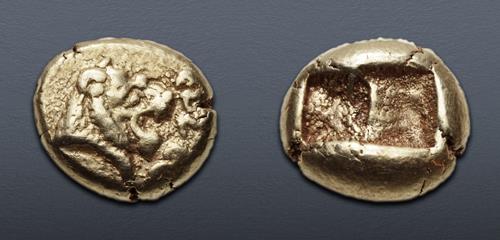|
KINGS of LYDIA. Alyattes. Circa 620/10-564/53 BC. EL Hekte – Sixth Stater (10mm, 2.28 g). Lydo-Milesian standard. Sardes mint. Confronted heads of roaring lions, “sun” on foreheads (die positioned to feature the left side lion); WALWE[L] (in Lydian) downward between / Two incuse squares. Weidauer Group XVII, 101–2 (same obv. die); Kurth G18 (same rev. punches[?] as illustration); SNG Ashmolean 754; SNG Kayhan 1012; Traité I 51–2. Minor edge splits, typical die wear. VF.
This rare issue has been the object of much scholarly debate. At the time of Weidauer's study, she argued that the names WALWET and […]KALIL[…] (the full legend was then unknown), are not the names of kings but more likely the names of magistrates. Since Weidauer's publication, other examples have come to light, allowing the full legend to be discerned as KUKALIṂ, which translates to "I [belong] to Kukaś" (for a detailed linguistic explanation of how this conclusion was reached, see Wallace, KUKALIṂ, p. 38). The Lydian name Kukaś could be transliterated into Greek as Gyges (Γύγης), just as the WALWET could be transliterated into Greek as Alyattes (Ἀλυάττης). Although G.M. Browne ("A new Lydian text," Kadmos 39 [2000], pp. 178-9) found it attractive to assign those coins with the KUKALIṂ legend to the early Lydian king Gyges (circa 680-644 BC), Wallace has shown on numismatic grounds that this cannot be correct. Observing punch links between hektai with the KUKALIṂ legend (Weidauer Group XVIII) and those with the WALWET legend (Weidauer Group XVII), as well as visible signs of wear and damage on these same punches between the two series, Wallace argues that the WALWET and KUKALIṂ issues were roughly contemporary. Thus, the Kukaś of the KUKALIṂ coinage was a close contemporary of Alyattes named Gyges, rather than the earlier Lydian king of the same name. Most likely this Kukaś was a member of the Lydian royal family, since the design for the anvil die may have derived from a royal seal showing opposing lion heads. Wallace further argues that there are two distinct groupings within the larger Lydian series, which can be attributed to separate mints, with the KUKALIṂ coins belonging to the group he assigns to a subsidiary, or "branch", mint. If these coins were struck by a subsidiary Lydian mint in one of the territories it controlled (cf. Herodotos 1.6.1), then Kukaś may have been its governor, just as Kroisos had been in Adramytion before he became king of Lydia (Nic. Dam. FGrH. 90, fr. 65).
While Wallace's evidence for the contemporaneity of the WALWET and KUKALIṂ coinage is firmly based, his evidence for the two groupings is speculative, and not convincing. First, he speculates that there are two forms of obverse dies, one with two opposing lion heads separated by the signature, and another form that shows only one lion head before which is the signature. An inspection of the published examples, however, shows this is probably incorrect. Whenever there is sufficient space on the dies to show whether there is an opposing head on the die, an opposing head is always present (cf. Weidauer 91-94, 97-98, and 100-102). All other examples do only show a single lion head, but all of these have flans that are too small to see whether another head is opposite the one that is visible (cf. Weidauer 95-96 and 99). It is therefore most likely that all of the trite and hekte dies feature two opposing heads separated by the signature. Wallace also argues that there is a distinct stylistic difference between the two groupings, with the "branch" mint group having a more "primitive and rustic" style. Again, an inspection of the published examples renders this subjective observation moot, as there is a wide variation of style across all of the dies, from which one may discern multiple groupings. What is more likely is that the dies were created by a variety of engravers, whose styles varied somewhat from one another. In sum, the WALWET and KUKALIṂ coinage were all likely struck contemporaneously during the reigns of Ardys or Allyates, at a single mint in the captial Sardes. The translation of the names, WALWET to Allyates and KUKALIṂ to Gyges, is certain, but the identification of these individuals and the reason for their use on this series are as yet unknown.
The final winners of all Triton XXV lots will be determined at the live public sale that will be held on 11-12 January 2022. Triton XXV – Session One – Greek Coinage (Part 1) will be held Tuesday morning, 11 January 2022 beginning at 9:00 AM ET.
Winning bids are subject to a 20% buyer's fee for bids placed on this website and 22.50% for all others.
We recognize that our users may have various Internet Browsers and Operating Systems. We like our visitors to have the best possible experience when using our bidding platform. However, we do recognize that it is impossible to develop applications that work identically, efficiently and effectively on all web browsers. The CNG bidding platform supports the latest stable major version and the stable previous version of Mozilla Firefox and Chrome.
|
